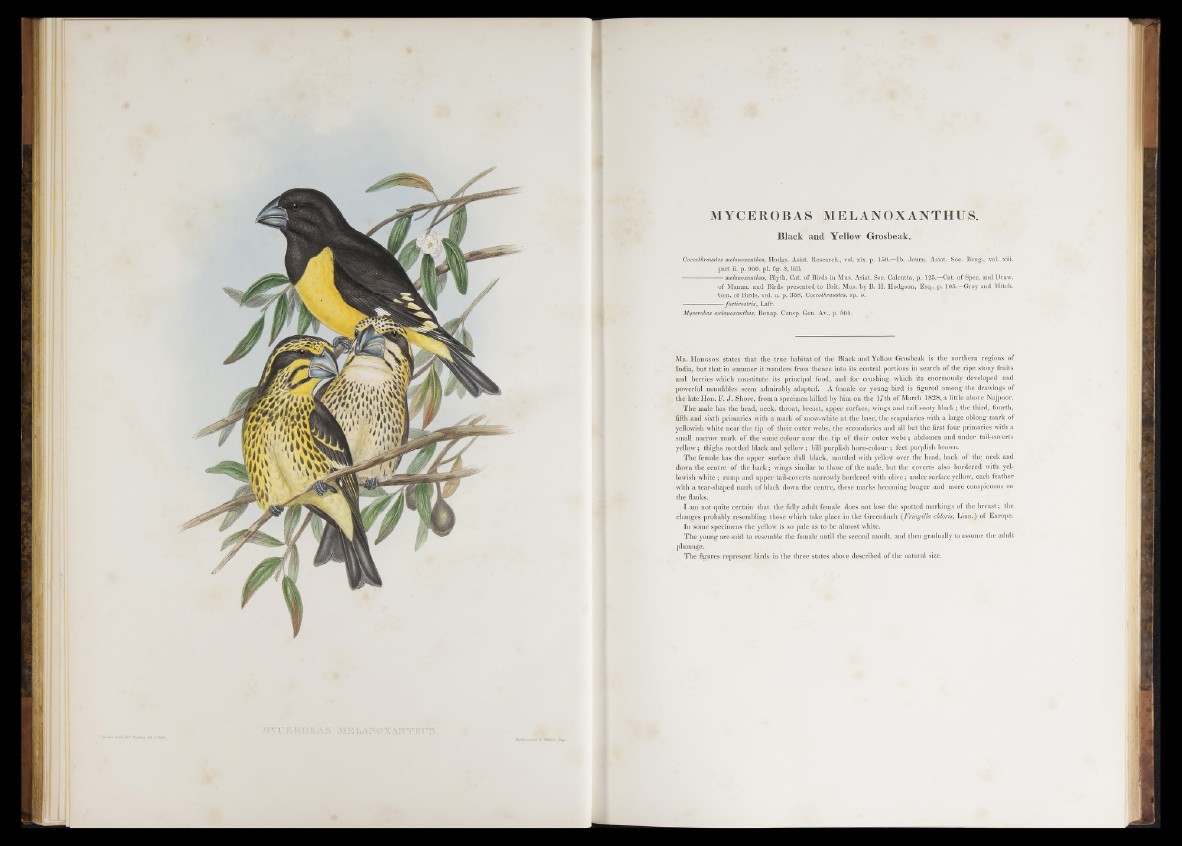
MYCEROBAS MELANOXANTHUS.
Black and Yellow Grosbeak.
Coccothraustes melanozanthos, Hodgs. Asiat. Research., vol. six. p . 150.—lb . Journ. Asiat. Soc. Beng., vol. xiii.
p a rt ii. p. 950. pi. fig. 3, bill.
melanoxanthus, Blyth, Cat. o f Birds in Mus. Asiat. Soc. Calcutta, p. 125.—Cat. of Spec, and Draw.
of Mamm. and Birds presented to Brit. Mus. by B. H. Hodgson, Esq., p. 105.—Gray and Mitch.
Gen. o f Birds, vol. ii. p. 358, Coccothraustes, sp. 5.
--------------------fortirostris, Laft.
Mycerobas melanoxanthus, Bonap. Consp. Gen. Av., p. 505.
M b . H o d g s o n states that the true habitat o f the Black and Yellow Grosbeak is the northern regions of
India, but th at in summer it wanders from thence into its central portions in search of the ripe stony fruits
and berries which constitute its principal food, and for crushing which its enormously developed and
powerful mandibles seem admirably adapted. A female or young bird is figured among the drawings of
the late Hon. F. J . Shore, from a specimen killed by him on the 17th of March 1828, a little above Najpoor.
The male has the head, neck, throat, breast, upper surface, wings and tail sooty black ; the third, fourth,
fifth and sixth primaries with a mark of snow-white a t the base, the scapularies with a large oblong mark of
yellowish white near the tip of their outer webs, the secondaries and all but the first four primaries with a
small narrow mark of the same colour near the tip of their outer webs ; abdomen and under tail-coverts
yellow ; thighs mottled black and yellow ; bill purplish horn-colour ; feet purplish brown.
The female has the upper surface dull black, mottled with yellow over the head, back of the neck and
down the centre of the back ; wings similar to those o f the male, but the coverts also bordered with yellowish
white ; rump and upper tail-coverts narrowly bordered with olive ; under surface yellow, each feather
with a tear-shaped mark of black down the centre, these marks becoming longer and more conspicuous on
the flanks.
I am not quite certain that the fully adult female does not lose the spotted markings of the breast ; the
changes probably resembling those which take place in the Greenfinch (Fringilla ciloris, Linn.) of Europe.
In some specimens the yellow is so pale as to be almost white.
The young are said to resemble the female until the second moult, and then gradually to assume the adult
plumage.
The figures represent birds in the three states above described of the natural size.